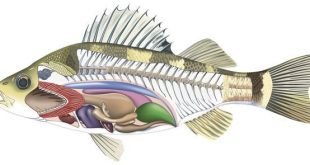Diversity of Freshwater Fishes
Despite representing only a miniscule (0.0093% according to Horn, 1972) part of the world’s aquatic habitat, freshwaters contain a disproportionate number of species (over 40%, again according to Horn, 1972). Unlike the oceans, which constitute broad, uninterrupted expanses of water, freshwater habitats tend to be much smaller in extent, and well separated from other similar habitats by expanses of dry land. Although broad stretches of open ocean may serve as an effective barrier to fish dispersal, dry land is much more effective as numerous zoogeographic studies have demonstrated, making freshwater habitats, to quote Dr. Melanie Stiassny of the American Museum of Natural History, “the ultimate island.”
Most of the 8000 or so freshwater fishes known (more turn up each year) live in lakes and rivers out of reach of the sea. Of these, the vast majority (87.5%) are primary freshwater fishes that evolved in freshwater, and exhibit low, if any, tolerance of seawater. Only a very few such fishes have adapted to spawning as well as living in brackish water, such as the cyprinids in the Caspian and Aral Seas, whose eggs can develop in salinities up to 8–10%. By far the majority (over 93%) of primary freshwater fishes are ostariophysan catfish, carps, and characins, the remainder, including the lungfishes, osteoglossids in Australia, South-East Asia, South America, and Africa, the weakly electric mormyrids in Africa, as well as a few widespread larger families such as the pikes (Esocidae), and perches (Percidae). Although most continents possess well-developed primary freshwater fish faunas, isolated regions may lack them. The only two certainly primary freshwater fishes of Australia are the lungfish Neoceratodus, and the osteoglossid Scleropages, the occurrence of these is believed to reflect the Pangean distribution of these two ancient lineages. The island of Madagascar, despite its proximity to Africa, possesses no primary freshwater fishes nor do the islands of the West Indies or Pacific Oceania.

Secondary freshwater fishes are those whose ancestors entered from the sea in the past and which often still retain close relatives living in the marine environment. Secondary freshwater fishes include the widespread Cichlidae, and numerous cyprinodontiform and atheriniform species, the southerly distributed Galaxiidae, and the Centrarchidae of North America. They mostly now live exclusively in freshwater, and, even though the main groups (cichlids, cyprinodonts, and poeciliids) have species that may have considerable salinity tolerance and can live and even breed in brackish water, most must spawn in freshwater. Several predominately marine families, such as clupeids, puffer fishes (Tetraodontidae), gobies (Gobiidae and related families), and drum fishes (sciaenids), have freshwater representatives, for example the small ctenothrissid clupeids of West African rivers or the Australian clupeid Nematalosa erebi. There are even a few entirely freshwater stingrays (Dasyatidae).
Diadromous fishes migrate between fresh and salt waters. Some, like the 19 lgfqor so species of freshwater eels (Anguilla), leave freshwater to spawn in the sea (catadromous species), making very interesting anticipatory changes in serum ion content, body color, and visual pigments before and during their passage downriver. As well as the eels, one or more pleuronectids, scorpaenids, and mullets (Mugilidae) are catadromous, although, aside from the eel, fresh water is not obligatory in most of these species (Dadswell et al., 1987). Many more (anadromous species) make the reverse migration to spawn in freshwater after periods up to 4 or 5 years growing and maturing in the sea. Parasitic lampreys, many salmonids, shads (Alosa, Ilisha), and alewives (Pomolobus), and smelts (Osmeridae) are all anadromous. A third category of diadromous fishes, amphidromous species, migrates into or out of the sea but do not do so for breeding purposes. For example, the newly hatched larvae of the ayu (Plecoglossus altivelis), a fish much prized as a delicacy in Japan, are swept downstream to the sea whence they return as small juveniles to grow and feed for several years before breeding. A similar situation is seen in the southern salmoniform galaxeids. McDowall has examined the systematic distribution of diadromy in teleosts, concluding that it is an ancient life-history style making it difficult to ascertain for modern groups whether they might have had a marine or freshwater origin (McDowall, 2002).

As with marine habitats, there are distinctly different types of freshwater habitats: lakes, ponds, pools, rivers, streams, and springs, and within each of these numerous microhabitats may exist a high degree of ecological and genetic diversity among freshwater fishes.
Lentic Systems
Stillwater, or lentic, habitats include lakes, ponds, and impoundments. Although these habitats vary tremendously in their sizes, origins, and ages, all have certain common physical characteristics and are inhabited by similar fish communities.
As in the oceans, deeper lakes may exhibit vertical zonation in their physico-chemical and biotic variables. The shallow zone around the edge of a lake, the littoral, may support a community of rooted aquatic plants, benthic invertebrates (chiefly arthropods and annelids) as well as diverse bottom-oriented fish community (sunfishes, catfishes, and suckers).
In deep lakes the combination of temperature and water density (itself temperature dependent) can create thermal stratification separating a community of planktivorous fishes (atherinids, clupeids, and their relatives) that dwells in the epilimnion, while the deep bottom-water layer, the hypolimnion, provides habitat for predatory as well as bottom-feeding fish species. This stratification can lead to oxygen depletion, even anoxia, in the hypolimnion and to the phenomenon known as turnover when in response to cooling surface temperatures the thermocline gradually rises to the surface permitting the cold oxygen-poor deep waters to mix with surface waters. The resultant drop in dissolved oxygen can produce considerable stress and sometimes massive fish kills. The thermocline zone may contain a fish community distinct from both the epi- and hypolimnion.
In the tropics, stratification can also occur, but the lack of seasonal temperature variations means the thermocline is more stable and turnover rarely, if ever, occurs. This leads to a more-or-less permanently anoxic hypolimnion that cannot support fish or most other aquatic life.
Lotic systems
Flowing water, or lotic systems, such as streams and rivers, exhibit little, if any, stratification, however, longitudinal differences in gradient, temperature, water velocity, bottom type, width, and depth, and other features create distinct habitats in which different fish communities may be found. In general there is a correlation between stream order and fish species diversity due to increasing complexity and variety of habitats in the downstream reaches.
Since rivers are continuous from their headwaters to their mouths, fish can often pass between adjacent reaches and some broadly adapted species may occur nearly throughout the entire length of the river, however, most rivers can be divided into zones or reaches differentiated by width, bottom type or current, each with a distinctive fish community.
Tropical rivers support a higher diversity of fish species than their temperate counterparts. The world’s largest river system, the Amazon, contains over 2000 species with more than 50 new species being described each year (Lundberg and Troll, 2001), while the Congo system in Africa has about 700. In comparison, the Mississippi-Missouri system of North America has fewer than 400 species. As in tropical lakes, speciation has produced a wide variety of trophic and other specializations for living in the slow, turbid, and frequently anoxic waters. Although season flooding plays an important role in the ecology of many temperate coastal rivers, such floods may be more essential in the life cycles of many tropical river fishes where numerous species take advantage of the expanded habitat of the flood plain to spawn and feed. Frugivorous fish species that are almost unique to the tropics also play a role in determining the distribution of floodplain trees similar to the roles of terrestrial bird and mammal frugivores.
 EazyBio: Educate, Elevate, Empower EazyBio: Educate, Elevate, Empower
EazyBio: Educate, Elevate, Empower EazyBio: Educate, Elevate, Empower




